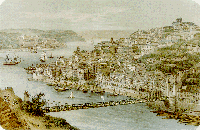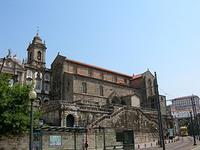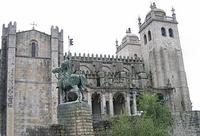Oporto » City Info » History

The early references of Oporto (or Porto) dates back to the 4th century. During the Roman times the city gained prominence as a commercial port, primarily for trade between Olissipona (Lisbon) and Bracara Augusta (Braga).
In 711, the Iberian Peninsula came under the rule of the Moors. This land was later reclaimed from the Moors. The reclaimed land also included the settlement of Portus Cale later known as Portucale. Count Vimara Pares established the first County of Portugal in 868.
The Portuguese-English alliance was made through the Treaty of Windsor in 1386 and is the oldest military record of an alliance. The Portuguese shipbuilding developed remarkably in the 14th and 15th century. Prince Henry along with his fleet, embarked on a mission to conquer the Moorish port Ceuta, in Northern Morocco. This was followed by further exploration of the northern coast of Africa. Prince Henry's quest of exploration initiated the Portuguese 'Age of Discovery'.

18th Century
Trade relations were established between England and Oporto by the Metheun Treaty of 1704. An English trading port was established in Oporto. Making of the port wine fell into the hands of a handful of English firms. To counter attack the English dominance, a Portuguese firm was established by Prime Minister Marquis of Pombal. The firm had sole monopoly of wines from the Douro valley. The first effort to control production and quality of wine in Europe was made during the time in Oporto. The small winegrowers however, revolted against these stringent measures. This revolt by the winegrowers is called as 'Revolta dos Borrachos' meaning 'Revolt of the Drunks'.
A baroque church, 'Torre dos Clérigos', designed by Italian architect Nicolau Nasoni constructed between 1732 and 1763, became the architectural icon of Oporto. Oporto increased in population as well as commercial trade during this era.
Photo Credit: Creative Commons/Maragato1976

19th Century
War was brought home to Oporto when Napoleon troops invaded Oporto. People tried to flee the troop by crossing the Douro River, over a pontoon bridge. The bridge collapsed under the weight. The event in Oporto history is marked by a plaque at the Ponte D. Luis I. Arthur Wellesley, 1st Duke of Wellington, rooted the French troops out of Oporto through an ingenious coop. Wine barges were used to transport the troops and outflank the French Army. In 1820s, Oporto suffered a Civil War between an absolute regime led by D.Miguel and those supporting Constitutionalism and a change of regime. The liberal assembly of Oporto succeeded in establishing a liberal constitution in 1822. Miguel of Portugal took over as an absolute monarch in 1828. Oporto had to undergo a siege of eighteen months by the absolutism army, as it rebelled against this regime. After defeating the Miguelist rule, Oporto came to be called as "Cidade Invicta" meaning Unvanquished City. The abdication of King Miguel saw the re-establishment of the liberal constitution. A Portuguese Republic was created in 1910 as the ultimate result of the revolt by the Republicans.
Photo Credit: Creative Commons/Henrique Matos
20th Century
Oporto was the capital of the kingdom, when Monarchy of the North was proclaimed in 1919. This was overthrown a month later and no other monarchic revolt took place again in Oporto. The historic city centre of Oporto was declared a World Heritage Site by UNESCO in 1996. Since then, many tourists have visited the city to view its architectural highlights like Oporto Cathedral, Church of Saint Francis, Church of Cedofeita, and Igreja de São Francisco.
Search news: Advanced
Contact our Advertising team for Advertising or Sponsorship on TravelAgents.com NetworkThis site is owned and managed by WN Network.
